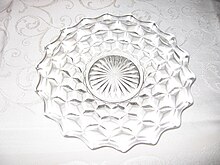Elegant glass


Elegant glass is high quality glassware created in the United States during the Depression Era. It was sold for high prices in department stores and given as wedding gifts.[1] When new, Elegant glass would cost more than its oft-confused counterpart, Depression glass, because it was at least partially handmade, had a cleaner finish, and more vibrant colors. From the 1920s through the 1950s, Elegant glass was an alternative to fine china. Most of the Elegant glassware manufacturers closed by the end of the 1950s, and cheap glassware and imported china took its place.
Manufacturing process
Elegant glass was at least partially hand made during production.[2] Elegant glass manufacturers produced vibrant colors that varied far more than Depression Glass.[1] Shades of red, blue, green, amber, yellow, smoke, amethyst, and pink were produced. An easy way to compare the difference in color quality is to take a look at a piece of cobalt Elegant glass and place it alongside a piece of cobalt Depression Glass. The intensity of the former piece is quite evident. Pressed Elegant glass was fire polished to get rid of the flaws in the glass. The normal flaws found in pressed glass – straw marks, raised seams, etc. were removed. The base of bowls, platters, etc. was ground so it would sit evenly on a table. Many patterns of Elegant glass were embellished with acid etching, cutting, enamel decoration, gold encrustation, platinum and gold trim.[1]
Sale and marketing
Elegant glass was sold in the finer stores (never given away). It was also marketed as wedding patterns. It was offered as an alternative to china and crystal which were still imported due to manufacturing costs and were incredibly expensive. Many consumers purchased Elegant glass and placed it on display, only using it for very special occasions.[1]
Products
Elegant glass patterns had a wide range of items available including:
Tableware
Tableware included plates, bowls, platters, sherbets, salt and pepper shakers, compotes, creamers, sugar bowls, epergnes, mayonnaise bowls, place holders, baskets, candy dishes, cruets, bells, candlesticks, cheese stands, bread and butter plates, baskets, bon bons, jam/jelly jars, tidbit trays, nut dishes, celery dishes, pickle dishes, lamps, cracker jars, oil and vinegar bottles, marmalade jars, and vases.[3]
Barware
Barware includes card trays, milk pitchers, jugs, cigarette holders, coasters, cordial glasses, cocktails glasses, decanters, bitters bottles, ice buckets, water goblets, wine glasses, ashtrays, and muddlers.[4][3]
Manufacturers and patterns
Companies that made Elegant glass and the patterns they produced.[5][1][4][6]
|
|
|
Etching patterns
Companies and artists that designed acid etching, cutting, enamel decoration, gold encrustation, platinum and gold trim but did not create glass.[1]
- Lotus
- Bridal Bouquet
- Flanders
Pattern gallery
Cambridge
-
Apple Blossom
-
Caprice
-
Chantilly
-
Chrysanthemum
-
Cleo
-
Diane
-
Elaine
-
Gloria
-
Gradroon
-
Lorna
-
Magnolia
-
Maryland
-
Rosalie
-
Rosepoint
-
Seashell
-
Springtime
-
Wedgewood
Diamond Glass Company
-
Charade
New Martinsville Glass Company
-
Janice
-
Moondrops
-
Radiance
See also
References
- ^ a b c d e f "Elegant Glass is Not Depression Glass | Just Glass Online." Designer Glassware, Vintage Art Glass, Depression Glass & Collectible Glass | Just Glass Online. Stephen Thornton Internet Consulting Services. Web. 8 January 2010. <http://www.justglass-online.com/collectibles/elegant-glass-is-not-depression-glass.html Archived 31 December 2010 at the Wayback Machine>.
- ^ "Depression Glass, Elegant Glass and Depression Glass Manufacturers | Just Glass Online." Designer Glassware, Vintage Art Glass, Depression Glass & Collectible Glass | Just Glass Online. Stephen Thornton Internet Consulting Services. Web. 7 January 2010. <"Archived copy". Archived from the original on 31 December 2010. Retrieved 7 January 2010.
{{cite web}}: CS1 maint: archived copy as title (link)> - ^ a b "CAMBRIDGE CAPRICE-CLEAR at Replacements, Ltd." Replacements, Ltd. Replacements, Ltd. Web. 8 January 2010. <http://www.replacements.com/webquote/CAMCAPR.htm#300690>.
- ^ a b "Depression vs. Elegant Glass | WorthPoint." Antiques, Art and Collectibles - What's it Worth? | WorthPoint. Web. 6 January 2010. <http://www.worthpoint.com/blog-entry/depression-vs-elegant-glass>
- ^ Prochaska, Suzanne. "Depression Era Elegant Glass." Elegant Glass. Web. 6 January 2010. <http://www.suziemax.com/Depression-Era-Elegant-Glass.html>.
- ^ "Centennial Antiques Reference Library." Centennial Antiques homepage. Vicki Young. Web. 10 January 2010. <http://centennialantiques.com>.
External links
Elegant Glass Identification:






















